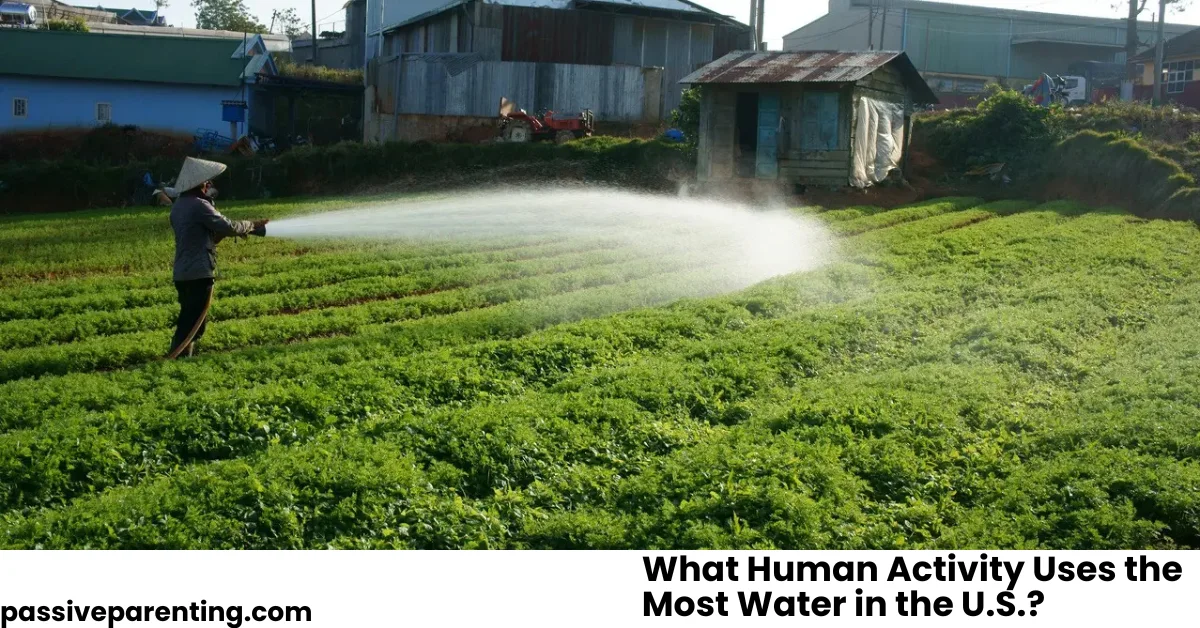Water is one of the most valuable resources on Earth. Every part of our lives from eating and cleaning to producing energy and growing crops depends on it. Yet, not all activities use water equally. Many people wonder: what human activity uses the most water in the United States?
The simple answer is agriculture, especially irrigation for crops. But that’s only part of the story. To truly understand water consumption, we need to explore how water is used across industries, homes, and energy systems and why some sectors use far more than others.
This detailed guide will break down how water use is distributed in the U.S., why agriculture dominates, and what we can do to ensure a more sustainable future.
What Human Activity Uses the Most Water in the United States?
In the United States, agriculture particularly irrigation uses the most water of any human activity. Roughly 40–45% of all freshwater withdrawals nationwide go toward growing crops and raising livestock.
From massive cornfields in the Midwest to vegetable farms in California, American agriculture depends heavily on irrigation. Many farms are located in regions that receive limited rainfall, making artificial watering systems vital for production.
The sheer scale of U.S. farming explains why agriculture sits at the top of the water consumption list. Feeding a population of over 330 million people plus supporting global exports, demands enormous water resources.
How U.S. Water Use Is Divided by Sector
To see how water use breaks down, it helps to look at the country’s major sectors. Water use in the United States is typically divided into four primary categories:
- Agriculture (irrigation and livestock)
- Thermoelectric power generation
- Industrial use
- Public supply (domestic and municipal use)
Let’s explore each one to understand how they compare.
1. Agriculture and Irrigation: The Top Water Consumer
Agriculture consumes more water than any other activity in the United States. The majority goes toward irrigating crops providing consistent moisture where rainfall alone isn’t enough.
Why Agriculture Uses So Much Water
- Crop Irrigation: Large-scale farms rely on irrigation systems to grow staples like corn, soybeans, cotton, and alfalfa. These crops require vast amounts of water to thrive.
- Livestock Needs: Water is also essential for animals for drinking, cleaning, and processing feed.
- Food Processing: Beyond farming itself, water supports washing, packaging, and preparing agricultural products.
High-Demand Regions
States like California, Texas, Nebraska, and Arkansas use the most water for irrigation. California’s Central Valley alone accounts for a huge percentage of national agricultural water use due to its year-round growing seasons and extensive fruit and vegetable production.
Impact of Irrigation Systems
Traditional methods like flood irrigation waste significant amounts of water. However, modern systems such as drip or sprinkler irrigation are becoming more common, helping farmers conserve resources while maintaining crop yields.
2. Thermoelectric Power Generation
The second-largest user of water in the U.S. is thermoelectric power generation, which includes coal, natural gas, and nuclear plants. These facilities require water for cooling systems that prevent overheating during electricity production.
How Power Plants Use Water
- Cooling and Condensation: Most plants draw water from rivers, lakes, or oceans to cool steam back into liquid form.
- Closed-Loop Systems: Some plants recycle water through cooling towers, reducing withdrawals.
While the total amount of water withdrawn for energy generation is enormous, much of it is returned to the environment after use. Still, the process affects water temperature and quality, influencing aquatic ecosystems.
With the growth of renewable energy, such as wind and solar, overall water demand from the power sector is gradually decreasing.
3. Industrial Water Use
Industrial operations such as manufacturing, mining, and chemical production also consume significant amounts of water, though less than agriculture or energy production.
Where Industry Uses Water
- Manufacturing Processes: Many products, from cars to electronics, require water during production.
- Cooling and Cleaning: Factories use water to cool machinery and clean materials.
- Food and Beverage Production: Water is a critical ingredient in everything from soft drinks to processed foods.
Industries have been improving water efficiency in recent years through recycling systems and wastewater treatment, reducing the amount of freshwater needed for daily operations.
4. Public and Domestic Water Use
Domestic or municipal use the water people use at home, represents a much smaller portion of total water consumption compared to agriculture or power generation.
How Households Use Water
- Indoor uses: Toilets, showers, sinks, dishwashers, and laundry.
- Outdoor uses: Lawn watering, car washing, and pools.
On average, an American household uses about 300 gallons of water per day, with nearly 30% of that going to outdoor landscaping.
Simple changes like fixing leaks, switching to low-flow fixtures, and adjusting lawn watering schedules can dramatically reduce residential water use.
Why Agriculture Dominates U.S. Water Consumption
Agriculture’s massive water use is tied directly to the country’s role as a global food producer. Here’s why it consumes so much:
- Extensive Farmland: The U.S. has millions of acres dedicated to crops that require irrigation.
- Climate Conditions: Many top-producing states face low rainfall, making irrigation essential.
- High-Value Crops: Water-intensive crops like almonds, alfalfa, and rice are profitable but require large volumes of water.
- Livestock Operations: Beef, dairy, and poultry farms use significant water for animals and feed.
- Export Demand: U.S. farms supply not just domestic markets but international buyers as well.
While necessary, this level of water use raises sustainability questions, especially as droughts and groundwater depletion become more common.
Regional Water Use Patterns
Water use in the U.S. isn’t evenly distributed. Geography and climate play a huge role in how water is consumed across regions.
Western United States
The West is the largest consumer of irrigation water due to arid conditions and extensive agricultural land. States like California, Arizona, and Nevada rely heavily on groundwater and river systems such as the Colorado River.
Midwestern States
The Midwest uses water primarily for farming and industry. Corn and soybean farming dominates, requiring consistent irrigation in dry seasons.
Eastern United States
In the East, where rainfall is more abundant, public supply and industrial use account for most water consumption. Large populations in states like Florida and New York drive domestic demand.
These variations highlight how location influences both water use and conservation strategies.
Environmental Impacts of Excessive Water Use
While water supports life and productivity, overuse can have lasting consequences.
1. Groundwater Depletion
Heavy irrigation has caused major declines in groundwater levels, especially in the Ogallala Aquifer, which supports much of the Midwest’s agriculture.
2. River and Reservoir Strain
Major water sources like the Colorado River are struggling to meet agricultural and urban demand, leading to conflicts among states.
3. Soil Degradation
Over-irrigation can lead to soil salinization, reducing fertility and long-term crop yields.
4. Ecological Damage
Warm discharge water from power plants and reduced river flow impact aquatic life and biodiversity.
Addressing these challenges requires smarter management and investment in sustainable technology.
Water Conservation and Sustainable Practices
Efficient water use is possible with the right tools, technology, and awareness. Here’s how different sectors are improving sustainability:
In Agriculture:
- Drip Irrigation: Delivers water directly to plant roots, reducing waste.
- Soil Moisture Sensors: Helps farmers monitor when irrigation is actually needed.
- Crop Selection: Choosing drought-resistant crops to adapt to local climates.
- Recycling Water: Using treated wastewater for irrigation instead of freshwater.
In Industry and Energy:
- Recycling and reusing cooling water.
- Switching to closed-loop cooling systems in power plants.
- Incorporating water-efficient manufacturing processes.
At Home:
- Fixing leaks and installing low-flow fixtures.
- Using drought-tolerant plants in landscaping.
- Running full loads in washing machines and dishwashers.
- Collecting rainwater for outdoor use.
These collective efforts can significantly reduce national water consumption over time.
The Future of Water Use in the United States
The demand for water is expected to rise due to population growth, climate change, and increased food production. However, technological innovation offers hope.
- Smart irrigation systems will optimize crop watering.
- Renewable energy will lower water dependency in the power sector.
- Public awareness campaigns will promote conservation at every level.
- Government policies will increasingly target efficient water management and sustainable farming practices.
To ensure future availability, the U.S. must continue to balance growth with environmental responsibility.
Conclusion
When it comes to what human activity uses the most water in the United States, the answer is clear agriculture leads the way. Irrigation alone accounts for nearly half of all freshwater withdrawals nationwide.
However, as demand grows and water sources become more strained, sustainable management is no longer optional, it’s essential. From farmers adopting smarter irrigation systems to individuals cutting back on household waste, every action counts.




